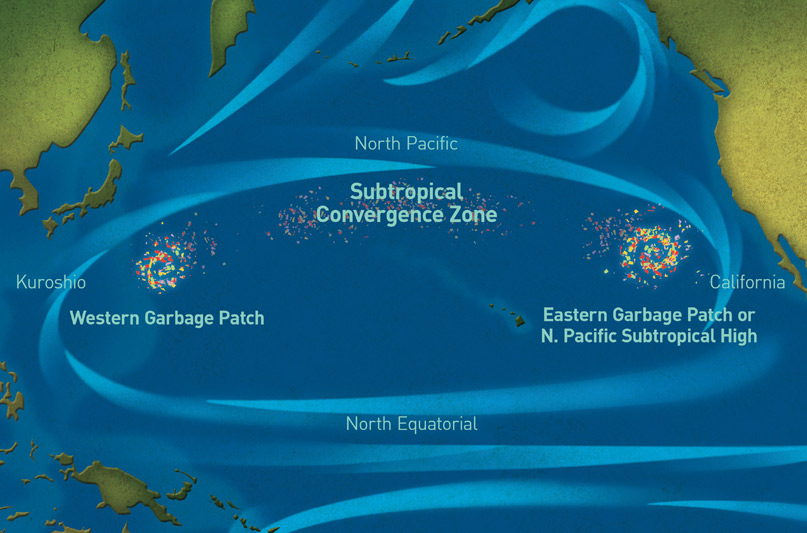A sailor transiting from Puget Sound to Hawaii might not even notice it with a naked eye, but the Great Pacific Garbage Patch (GPGP) is undeniably on the route and growing. Caught in the North Pacific Gyre is an area of plastic debris that is far larger than previously thought and growing every day. The GPGP contains plastic from the last four decades and all the countries on the Pacific Rim. A study published by Scientific Reports in late March concluded that the patch had an area of over 600,000 square miles, or an area twice the size of Texas (1). Estimations of its weight range from 80,000 tons to 7 million tons (1).

However, the “Garbage Patch” is a bit of a misnomer: the patch is not a solid field of plastic, but closer to a soup of plastic debris mostly floating just below the surface of the water. Satellites can’t see it and radar can’t detect it. There are large pieces of plastic, fishing nets, and water bottles, but much of the plastic are pieces the size of confetti or smaller. The area of the patch is ascertained using in situ water samples, which is why its size is difficult to determine. These microplastics and microfibers may be difficult to see, but they may be more dangerous to the environment than their macro-sized counterparts as they are readily ingested by plankton, the basis of the marine food chain (2).
Efforts to clean the ocean of microplastics have been steadily growing. Fraser Yachts announced a partnership with The Plastics Oceans Foundation, a global network of independent nonprofits and charitable organizations devoted to changing the world’s attitude toward plastic waste. This is just one of many notable industry examples.
“Every year we are producing more than 300 million tonnes (270 million tons) of plastic, half of this is designed for single use, and each year around 8 million tonnes of it ends up in our oceans,” said David Jones of the Plastic Oceans Foundation in a press release. “We are genuinely thrilled that a prestigious company like Fraser Yachts has shown so much enthusiasm for what we are trying to achieve and has agreed to commit resources and to use its global voice to help us change the way we deal with plastic waste.”
Raphael Sauleau, Chief Executive Officer of Fraser Yachts, also voiced his opinion in the same press release, “We are always looking for ways to protect the environment and give back to the oceans that we make our livelihood from; we want to make sure that the oceans remain a beautiful place for many people to enjoy for future generations. We were very impressed with the work and the enthusiasm of Plastic Oceans. One of the great features of their strategy is that it is relatively simple to put in place, if everyone made a little effort it will result in a huge impact. We know that this topic is also close to the hearts of our clients and we look forward to working with them on various initiatives.”
While the task of cleaning the oceans may seem herculean, the combined efforts of all segments of society may just be the key to ending the excessive plastic waste of the modern era. You can learn more about the Fraser Yachts/Plastic Oceans Foundation partnership at fraseryachts.com.
Cited:
- 1. Evidence that the Great Pacifc Garbage Patch is rapidly accumulating plastic
L. Lebreton1,2, B. Slat1, F. Ferrari1, B. Sainte-Rose1, J. Aitken3, R. Marthouse3, S. Hajbane1, S. Cunsolo1,4, A. Schwarz1, A. Levivier1, K. Noble1,5, P. Debeljak 1,6, H. Maral1,7, R. Schoeneich-Argent1,8, R. Brambini1,9 & J. Reisser 1; Scientific Reports 8, Article Number: 4666 (2018); Doi:10.1038/s41598-018-22939-w - 2. Microplastic Ingestion by Zooplankton
Matthew Cole, Pennie Lindeque, Elaine Fileman, Claudia Halsband, Rhys Goodhead, Julian Moger, and Tamara S. Galloway; Environmental Science & Technology 2013 47 (12), 6646-6655; DOI: 10.1021/es400663f